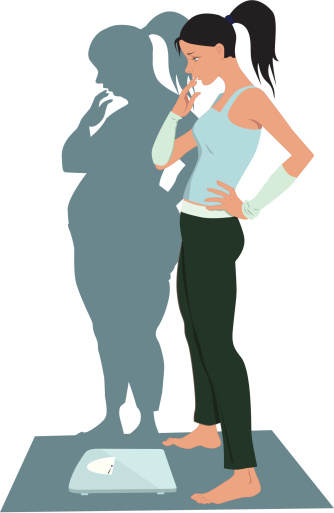Lesson 1: Clinical Disorders - Part A
PART A
Eating Disorders
Video: Eating Disorders
<
 In western society the prevalence of eating disorders is greater than in most other parts of the developed world. Eating disorders can take several forms: bulimia nervosa, anorexia nervosa, binge-eating disorder, and pica. In each of these disorders, individuals do not have a healthy relationship with food. In North America, much media coverage is given to both anorexia nervosa and bulimia nervosa.
In western society the prevalence of eating disorders is greater than in most other parts of the developed world. Eating disorders can take several forms: bulimia nervosa, anorexia nervosa, binge-eating disorder, and pica. In each of these disorders, individuals do not have a healthy relationship with food. In North America, much media coverage is given to both anorexia nervosa and bulimia nervosa.
With anorexia, a disorder first described over three hundred years ago, the patient experiences unhealthy and rapid weight loss. Afflicted individuals also have excessive concern with body shape and mass, are preoccupied with food and calories, and often have ritualized eating and food preparation habits. Individuals may skip meals, only eat certain foods, abuse laxatives, and exercise excessively. Body weight drops 15% below that considered healthy, and many individuals experience hair loss on their heads and hair growth elsewhere. In severe cases, the brain shrinks as the body, starving for nutrients, uses the fatty sheath surrounding nerve cells for energy. Thought processes are negatively affected and often a secondary addiction (such as compulsive shopping or alcohol abuse) accompanies this disorder as do various physical complications. Please refer to List 8.1 for a partial review of medical problems.
List 8.1:
Complications Resulting from Anorexia Nervosa
| - slow or irregular heart rate - heart failure - hypoglycemia - fluid in the sac enclosing the heart - amenorrhea (missing 3 consecutive periods) - lack of sexual interest or impotence - swelling of the salivary glands - stomach expansion |
- weakness - yellowing of the skin - dehydration - anemia - tooth decay - constipation - hypothermia - kidney damage |
The media can have a huge impact on the average person's self esteem, as magazines and movies usually portray beautiful individuals; many of whom are very thin. This can distort the image that we have of ourselves and make us feel fat, when in fact, you may be a healthy weight.
Watch this video that shows how the media can have an impact:
Barbie dolls have been around for generations of young women. As a result, her sleek figure can stick with young girls that think this is what beautiful looks like. However, in reality if we took Barbie's proportions and made a life-size Barbie, it would be a freakish woman with pencil-thin legs, breasts that threaten to
topple her over, and a body mass index that would put her in the anorexic range. Unfortunately, this is the role model that many young girls believe is beautiful.
young girls that think this is what beautiful looks like. However, in reality if we took Barbie's proportions and made a life-size Barbie, it would be a freakish woman with pencil-thin legs, breasts that threaten to
topple her over, and a body mass index that would put her in the anorexic range. Unfortunately, this is the role model that many young girls believe is beautiful.
Video: Amy's experience with anorexia.
 In cases of bulimia, sufferers are preoccupied with body image and body mass. An individual consumes massive amounts of food only to find a way to purge the calories from his or her body by vomiting, compulsively exercising, using diuretics, or abusing laxatives. A person with bulimia can be overweight, underweight, or of normal weight. Like those with anorexia, many patients with bulimia have secondary addictions. Some common complications from bulimia include tooth decay, enlarged heart, electrolyte imbalance, renal complications, dehydration, and kidney disease. For a DSM diagnosis, individuals must have a minimum of two binges per week for three months. Binging is most often done in secret where individuals consume an excessive amount of food (upwards of 20 000 calories per episode) followed by purging behaviour.
In cases of bulimia, sufferers are preoccupied with body image and body mass. An individual consumes massive amounts of food only to find a way to purge the calories from his or her body by vomiting, compulsively exercising, using diuretics, or abusing laxatives. A person with bulimia can be overweight, underweight, or of normal weight. Like those with anorexia, many patients with bulimia have secondary addictions. Some common complications from bulimia include tooth decay, enlarged heart, electrolyte imbalance, renal complications, dehydration, and kidney disease. For a DSM diagnosis, individuals must have a minimum of two binges per week for three months. Binging is most often done in secret where individuals consume an excessive amount of food (upwards of 20 000 calories per episode) followed by purging behaviour.
Like anorexia and bulimia, binge-eating disorders are more prevalent in women than men. Men, however, can make up 25% of binge-eaters. People suffering from this disorder are often overweight because they do not regularly fast, excessively exercise, or purge to control their weight. Some individuals continually eat throughout the day with no specific meal time while others have large binges in response to stress or anxiety. Similar to anorexia and bulimia, this disorder is often co-morbid with depression. Some research indicates a possible genetic link predisposing individuals to eating disorders. Popular culture suggests the increase of these disorders may be due in part to sociocultural factors (e.g., television, models, family dynamics) and/or sexual abuse. This research has yet to be substantiated.
Video: Demi Lovato talks about her eating disorder
Following are two case studies regarding eating disorders, the second of which describes pica. Pica is an eating disorder where non-food items (e.g., chalk, sawdust, paperclips) are ingested. Individuals have an abnormal desire to eat substances not normally eaten.